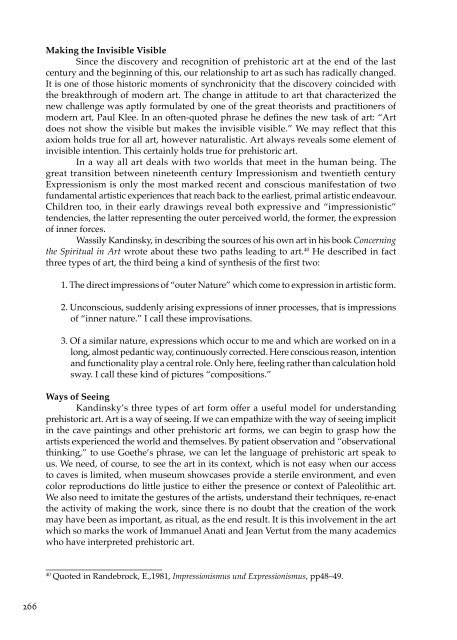The Spirit in Human Evolution - Waldorf Research Institute
The Spirit in Human Evolution - Waldorf Research Institute
The Spirit in Human Evolution - Waldorf Research Institute
Create successful ePaper yourself
Turn your PDF publications into a flip-book with our unique Google optimized e-Paper software.
Mak<strong>in</strong>g the Invisible Visible<br />
S<strong>in</strong>ce the discovery and recognition of prehistoric art at the end of the last<br />
century and the beg<strong>in</strong>n<strong>in</strong>g of this, our relationship to art as such has radically changed.<br />
It is one of those historic moments of synchronicity that the discovery co<strong>in</strong>cided with<br />
the breakthrough of modern art. <strong>The</strong> change <strong>in</strong> attitude to art that characterized the<br />
new challenge was aptly formulated by one of the great theorists and practitioners of<br />
modern art, Paul Klee. In an often-quoted phrase he def<strong>in</strong>es the new task of art: “Art<br />
does not show the visible but makes the <strong>in</strong>visible visible.” We may reflect that this<br />
axiom holds true for all art, however naturalistic. Art always reveals some element of<br />
<strong>in</strong>visible <strong>in</strong>tention. This certa<strong>in</strong>ly holds true for prehistoric art.<br />
In a way all art deals with two worlds that meet <strong>in</strong> the human be<strong>in</strong>g. <strong>The</strong><br />
great transition between n<strong>in</strong>eteenth century Impressionism and twentieth century<br />
Expressionism is only the most marked recent and conscious manifestation of two<br />
fundamental artistic experiences that reach back to the earliest, primal artistic endeavour.<br />
Children too, <strong>in</strong> their early draw<strong>in</strong>gs reveal both expressive and “impressionistic”<br />
tendencies, the latter represent<strong>in</strong>g the outer perceived world, the former, the expression<br />
of <strong>in</strong>ner forces.<br />
Wassily Kand<strong>in</strong>sky, <strong>in</strong> describ<strong>in</strong>g the sources of his own art <strong>in</strong> his book Concern<strong>in</strong>g<br />
the <strong>Spirit</strong>ual <strong>in</strong> Art wrote about these two paths lead<strong>in</strong>g to art. 40 He described <strong>in</strong> fact<br />
three types of art, the third be<strong>in</strong>g a k<strong>in</strong>d of synthesis of the first two:<br />
1. <strong>The</strong> direct impressions of “outer Nature” which come to expression <strong>in</strong> artistic form.<br />
2. Unconscious, suddenly aris<strong>in</strong>g expressions of <strong>in</strong>ner processes, that is impressions<br />
of “<strong>in</strong>ner nature.” I call these improvisations.<br />
3. Of a similar nature, expressions which occur to me and which are worked on <strong>in</strong> a<br />
long, almost pedantic way, cont<strong>in</strong>uously corrected. Here conscious reason, <strong>in</strong>tention<br />
and functionality play a central role. Only here, feel<strong>in</strong>g rather than calculation hold<br />
sway. I call these k<strong>in</strong>d of pictures “compositions.”<br />
Ways of See<strong>in</strong>g<br />
Kand<strong>in</strong>sky’s three types of art form offer a useful model for understand<strong>in</strong>g<br />
prehistoric art. Art is a way of see<strong>in</strong>g. If we can empathize with the way of see<strong>in</strong>g implicit<br />
<strong>in</strong> the cave pa<strong>in</strong>t<strong>in</strong>gs and other prehistoric art forms, we can beg<strong>in</strong> to grasp how the<br />
artists experienced the world and themselves. By patient observation and “observational<br />
th<strong>in</strong>k<strong>in</strong>g,” to use Goethe’s phrase, we can let the language of prehistoric art speak to<br />
us. We need, of course, to see the art <strong>in</strong> its context, which is not easy when our access<br />
to caves is limited, when museum showcases provide a sterile environment, and even<br />
color reproductions do little justice to either the presence or context of Paleolithic art.<br />
We also need to imitate the gestures of the artists, understand their techniques, re-enact<br />
the activity of mak<strong>in</strong>g the work, s<strong>in</strong>ce there is no doubt that the creation of the work<br />
may have been as important, as ritual, as the end result. It is this <strong>in</strong>volvement <strong>in</strong> the art<br />
which so marks the work of Immanuel Anati and Jean Vertut from the many academics<br />
who have <strong>in</strong>terpreted prehistoric art.<br />
_________________________<br />
40<br />
Quoted <strong>in</strong> Randebrock, E.,1981, Impressionismus und Expressionismus, pp48–49.<br />
266
















